The Influence of an Extended π Electron System on the Electrochemical Properties and Oxidizing Activity of a Series of Iron(III) Porphyrazines with Bulky Pyrrolyl Substituents
Abstract
:1. Introduction
2. Results and Discussion
2.1. Electrochemical Studies
2.2. Spectroelectrochemical Measurements
2.3. Oxidation Ability Studies
3. Materials and Methods
3.1. General Synthetic Procedures of Pz1–Pz4
3.2. Electrochemical Studies
3.3. Spectroelectrochemistry
3.4. Oxidation Reaction Studies
4. Conclusions
Supplementary Materials
Author Contributions
Funding
Institutional Review Board Statement
Informed Consent Statement
Data Availability Statement
Acknowledgments
Conflicts of Interest
Sample Availability
References
- Trivedi, E.R.; Vesper, B.J.; Weitman, H.; Ehrenberg, B.; Barrett, A.G.M.; Radosevich, J.A.; Hoffman, B.M. Chiral bis-Acetal Porphyrazines as Near-infrared Optical Agents for Detection and Treatment of Cancer. Photochem. Photobiol. 2010, 86, 410–417. [Google Scholar] [CrossRef]
- Manet, I.; Manoli, F.; Donzello, M.P.; Viola, E.; Masi, A.; Andreano, G.; Ricciardi, G.; Rosa, A.; Cellai, L.; Ercolani, C.; et al. Pyrazinoporphyrazines with Externally Appended Pyridine Rings. 13. Structure, UV–Visible Spectral Features, and Noncovalent Interaction with DNA of a Positively Charged Binuclear (ZnII/PtII) Macrocycle with Multimodal Anticancer Potentialities. Inorg. Chem. 2013, 52, 321–328. [Google Scholar] [CrossRef] [PubMed]
- Dubinina, T.V.; Dyumaeva, D.V.; Trashin, S.A.; Sedova, M.V.; Dudnik, A.S.; Borisova, N.E.; Tomilova, L.G.; Zefirov, N.S. Novel planar and sandwich-type complexes of substituted tetrathieno[2,3-b] porphyrazine: Synthesis and investigation of properties. Dye. Pigment. 2013, 96, 699–704. [Google Scholar] [CrossRef]
- Rodríguez-Morgade, M.S.; Stuzhin, P.A. The chemistry of porphyrazines: An overview. J. Porphyr. Phthalocyanines 2004, 8, 1129–1165. [Google Scholar] [CrossRef]
- Michel, S.L.J.; Hoffman, B.M.; Baum, S.M.; Barrett, A.G.M. Peripherally Functionalized Porphyrazines: Novel Metallomacrocycles with Broad, Untapped Potential; John Wiley & Sons, Inc.: Hoboken, NJ, USA, 2001; Volume 50, ISBN 0471435104. [Google Scholar]
- Theodoridis, A.; Maigut, J.; Puchta, R.; Kudrik, E.V.; Van Eldik, R. Novel Iron(III) Porphyrazine Complex. Complex Speciation and Reactions with NO and H2O2. Inorg. Chem. 2008, 47, 2994–3013. [Google Scholar] [CrossRef]
- Zhang, Z.; Wen, X.; Deng, K.; Zhang, B.; Lv, K.; Sun, J. Photodegradation of rhodamine B with molecular oxygen catalyzed by a novel unsymmetrical iron porphyrazine under simulated sunlight. Catal. Sci. Technol. 2013, 3, 1415. [Google Scholar] [CrossRef]
- Zhang, Z.; Peng, Q.; Sun, J.; Fang, L.; Deng, K. Enhancement of Catalytic Activities of a Biomimetic Catalyst FePz(dtnCl2)4 for the Wet Oxidation of Brilliant Red X3B through the Synergetic Effect of Heat and Light Irradiation Ind. Eng. Chem. Res. 2013, 52, 13342–13349. [Google Scholar] [CrossRef]
- Tang, J.; Chen, L.; Sun, J.; Lv, K.; Deng, K. Synthesis and properties of iron(II) tetra(1,4-dithiin)porphyrazine bearing peripheral long-chain alkyl group of active end-bromine. Inorg. Chem. Commun. 2010, 13, 236–239. [Google Scholar] [CrossRef]
- Su, R.; Sun, J.; Sun, Y.; Deng, K.; Cha, D.; Wang, D. Oxidative degradation of dye pollutants over a broad pH range using hydrogen peroxide catalyzed by FePz(dtnCl2)4. Chemosphere 2009, 77, 1146–1151. [Google Scholar] [CrossRef]
- Yang, C.; Sun, J.; Deng, K.; Wang, D. Synthesis and photocatalytic properties of iron(II)tetramethyl- tetra(1,4-dithiin)porphyrazine. Catal. Commun. 2008, 9, 321–326. [Google Scholar] [CrossRef]
- Koczorowski, T.; Cerbin-Koczorowska, M.; Rębiś, T. Azaporphyrins Embedded on Carbon-Based Nanomaterials for Potential Use in Electrochemical Sensing—A Review. Nanomaterials 2021, 11, 2861–2887. [Google Scholar] [CrossRef] [PubMed]
- Liao, M.; Watts, J.D.; Huang, M.-J.; Gorun, S.M.; Kar, T.; Scheiner, S. Fe(II) in different macrocycles: Electronic structures and properties. J. Phys. Chem. A 2005, 109, 7988–8000. [Google Scholar] [CrossRef]
- Fitzgerald, J.P.; Haggerty, B.S.; Rheingold, A.L.; May, L.; Brewer, G.A. Iron octaethyltetraazaporphyrins: Synthesis, characterization, coordination chemistry, and comparisons to related iron porphyrins and phthalocyanines. Inorg. Chem. 1992, 31, 2006–2013. [Google Scholar] [CrossRef]
- Krasnov, P.O.; Ivanova, V.N.; Basova, T.V. Carbon nanotubes functionalized with Zinc(II) phthalocyanines: Effect of the expanded aromatic system and aromatic substituents on the binding energy. Appl. Surf. Sci. 2021, 547, 149172. [Google Scholar] [CrossRef]
- Koczorowski, T.; Ber, J.; Sokolnicki, T.; Teubert, A.; Szczolko, W.; Goslinski, T. Electrochemical and catalytic assessment of peripheral bromoaryl-substituted manganese and iron porphyrazines. Dye. Pigment. 2020, 178, 108370. [Google Scholar] [CrossRef]
- Goslinski, T.; Osmalek, T.; Mielcarek, J. Photochemical and spectral characterization of peripherally modified porphyrazines. Polyhedron 2009, 28, 3839–3843. [Google Scholar] [CrossRef]
- Donzello, M.P.; Ercolani, C.; Stuzhin, P.A. Novel families of phthalocyanine-like macrocycles—Porphyrazines with annulated strongly electron-withdrawing 1,2,5-thia/selenodiazole rings. Coord. Chem. Rev. 2006, 250, 1530–1561. [Google Scholar] [CrossRef]
- Luo, Q.; Cheng, S.; Tian, H. Synthesis and photochromism of a new binuclear porphyrazinato magnesium(II). Tetrahedron Lett. 2004, 45, 7737–7740. [Google Scholar] [CrossRef]
- Goslinski, T.; White, A.J.P. Synthesis, characterization and spectroscopic properties of novel periphery—Functionalized unsymmetrical porphyrazines containing mixed dithienylpyrrolyl and dimethylamino groups. Polyhedron 2009, 28, 2579–2584. [Google Scholar] [CrossRef]
- Szczolko, W.; Wzgarda, A.; Koczorowski, T.; Wicher, B.; Sobotta, L.; Gdaniec, Z.; Gdaniec, M.; Mielcarek, J.; Tykarska, E.; Goslinski, T. The Suzuki cross-coupling reaction for the synthesis of porphyrazine possessing bulky 2,5-(biphenyl-4-yl)pyrrol-1-yl substituents in the periphery. Polyhedron 2015, 102, 462–468. [Google Scholar] [CrossRef]
- Koczorowski, T.; Szczolko, W.; Bakun, P.; Wicher, B.; Sobotta, L.; Gdaniec, M.; Teubert, A.; Mielcarek, J.; Tykarska, E.; Korecki, J.; et al. The Valence and Spin State Tuning of Iron(II/III) Porphyrazines with Bulky Pyrrolyl Periphery in Solution and Solid State. Molecules 2022, 27, 7820. [Google Scholar] [CrossRef] [PubMed]
- Decréau, R.; Chanon, M.; Julliard, M. Synthesis and characterization of a series of hexadecachlorinated phthalocyanines. Inorg. Chim. Acta 1999, 293, 80–87. [Google Scholar] [CrossRef]
- Goslinski, T.; Zhong, C.; Fuchter, M.J.; Stern, C.L.; White, A.J.P.; Barrett, A.G.M.; Hoffman, B.M. Porphyrazines as Molecular Scaffolds: Flexible Syntheses of Novel Multimetallic Complexes. Inorg. Chem. 2006, 45, 3686–3694. [Google Scholar] [CrossRef] [PubMed]
- Tuncer, S.; Koca, A.; Gül, A.; Avcata, U. Synthesis, characterization, electrochemistry and spectroelectrochemistry of novel soluble porphyrazines bearing unsaturated functional groups. Dye. Pigment. 2012, 92, 610–618. [Google Scholar] [CrossRef]
- Arıcı, M.; Arıcan, D.; Uğur, A.L.; Erdoğmuş, A.; Koca, A. Electrochemical and spectroelectrochemical characterization of newly synthesized manganese, cobalt, iron and copper phthalocyanines. Electrochim. Acta 2013, 87, 554–566. [Google Scholar] [CrossRef]
- Adebayo, A.I.; Nyokong, T. Synthesis, spectroscopic and electrochemical properties of manganese, nickel and iron octakis-(2-diethylaminoethanethiol)-phthalocyanine. Polyhedron 2009, 28, 2831–2838. [Google Scholar] [CrossRef]
- Stuzhin, P.A. Iron Complexes of Octaphenyltetraazaporphine. Macroheterocycles 2009, 2, 114–129. [Google Scholar] [CrossRef]
- Sobotta, L.; Fita, P.; Szczolko, W.; Wrotynski, M.; Wierzchowski, M.; Goslinski, T.; Mielcarek, J. Functional singlet oxygen generators based on porphyrazines with peripheral 2,5-dimethylpyrrol-1-yl and dimethylamino groups. J. Photochem. Photobiol. A Chem. 2013, 269, 9–16. [Google Scholar] [CrossRef]
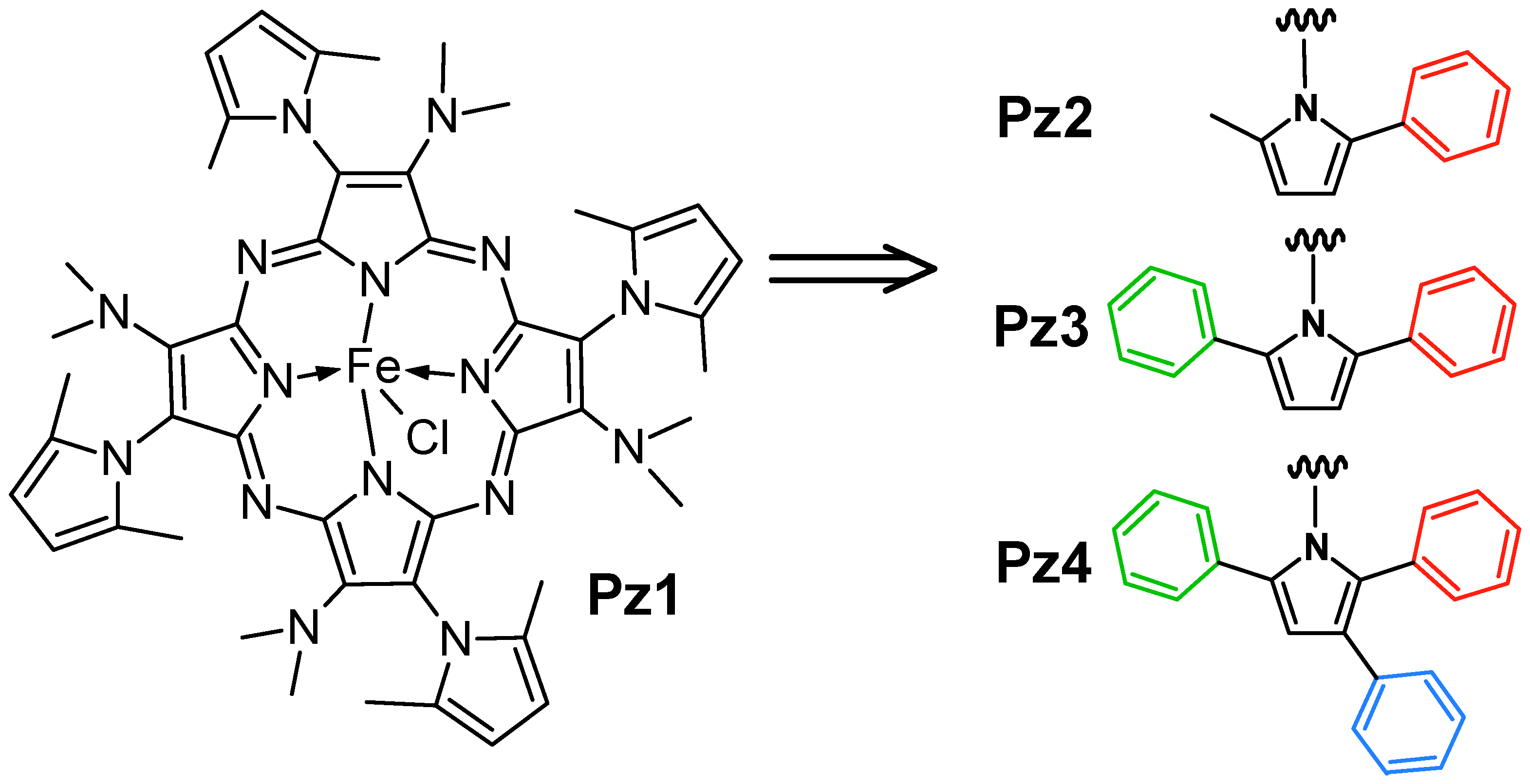

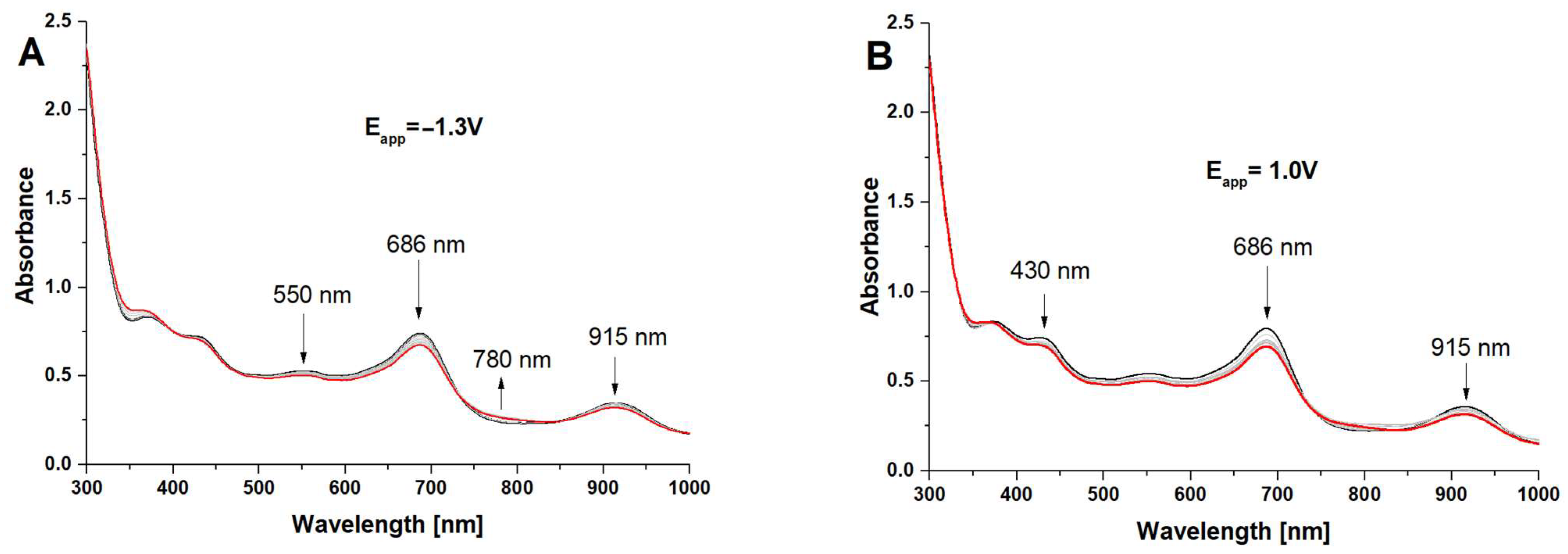
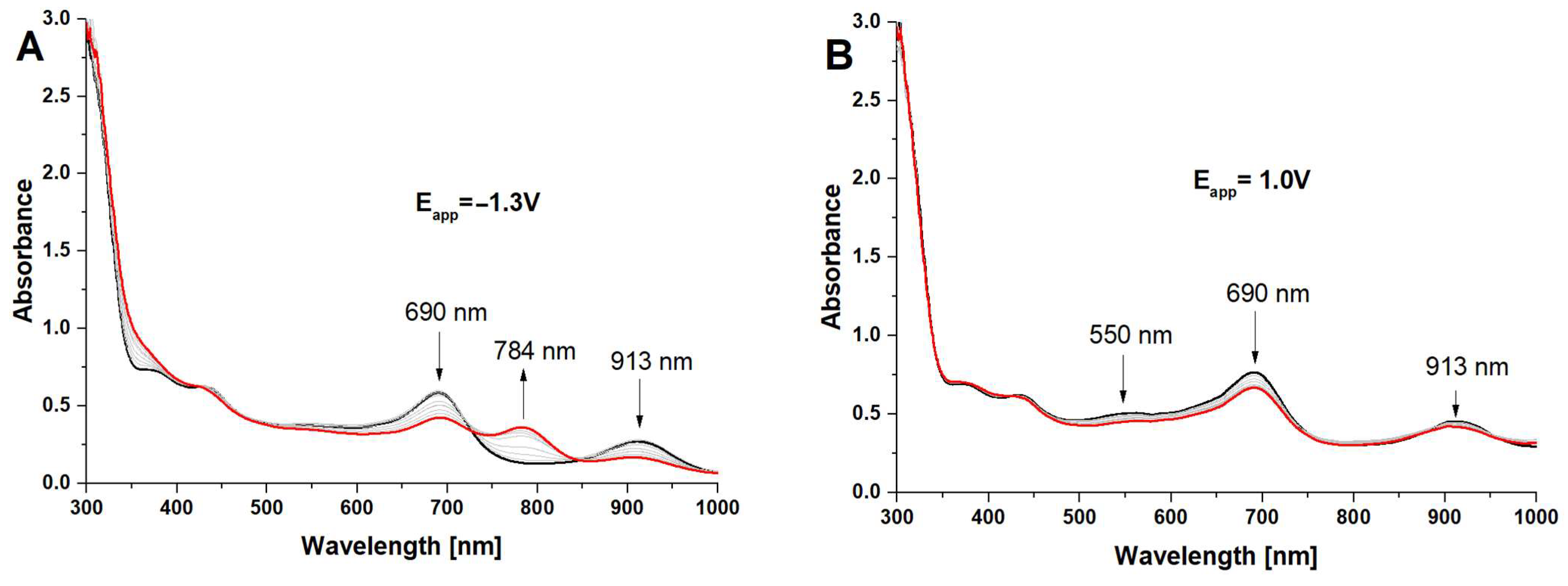
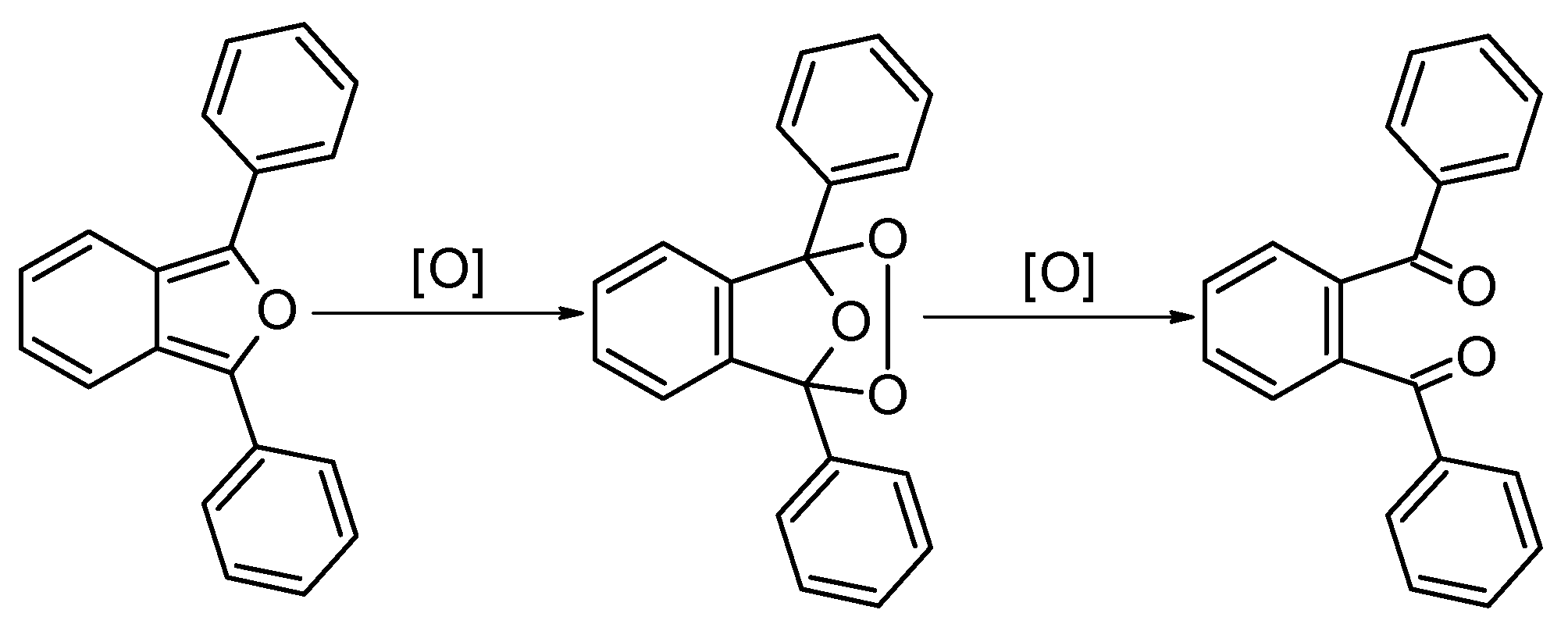
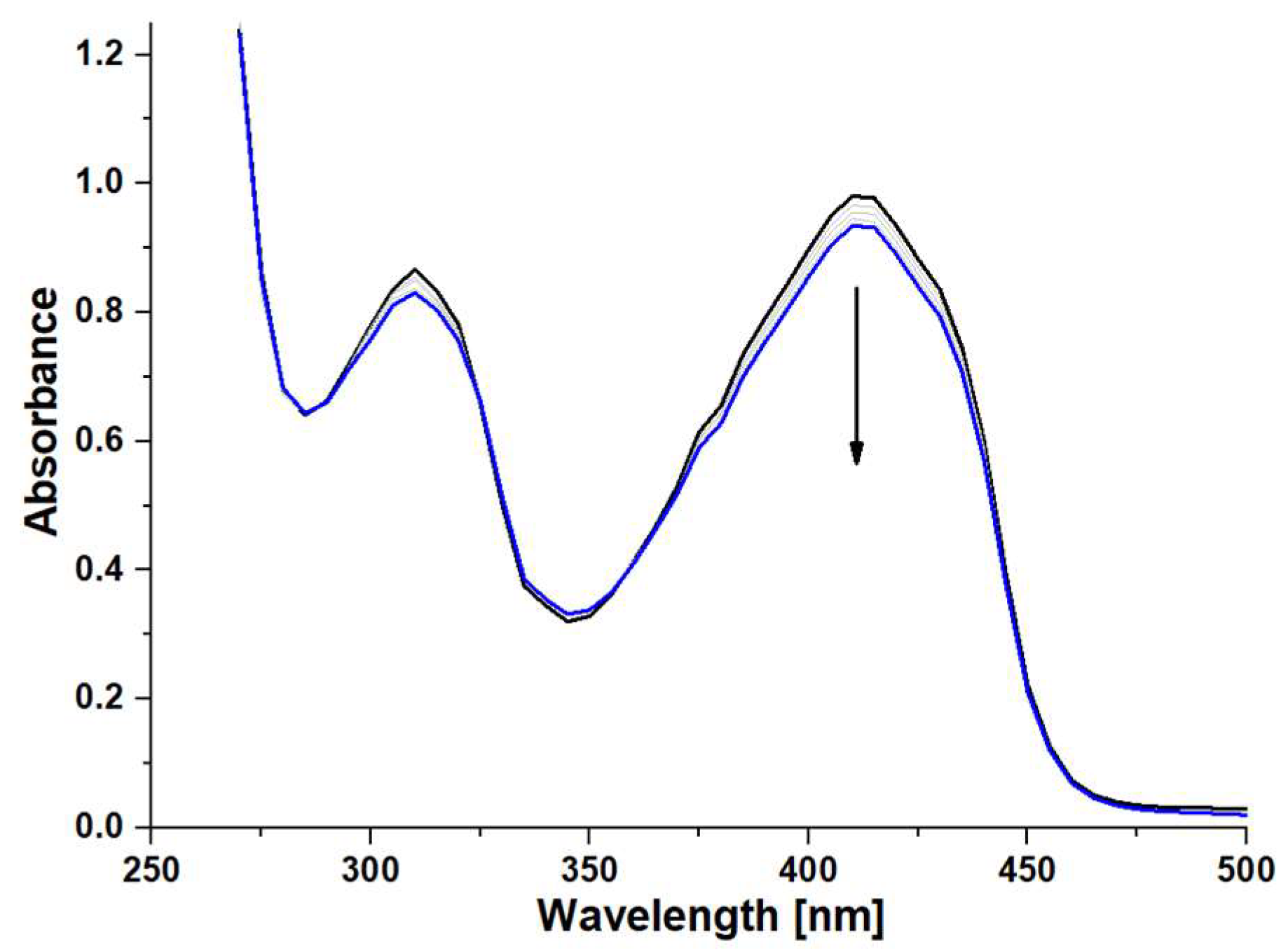

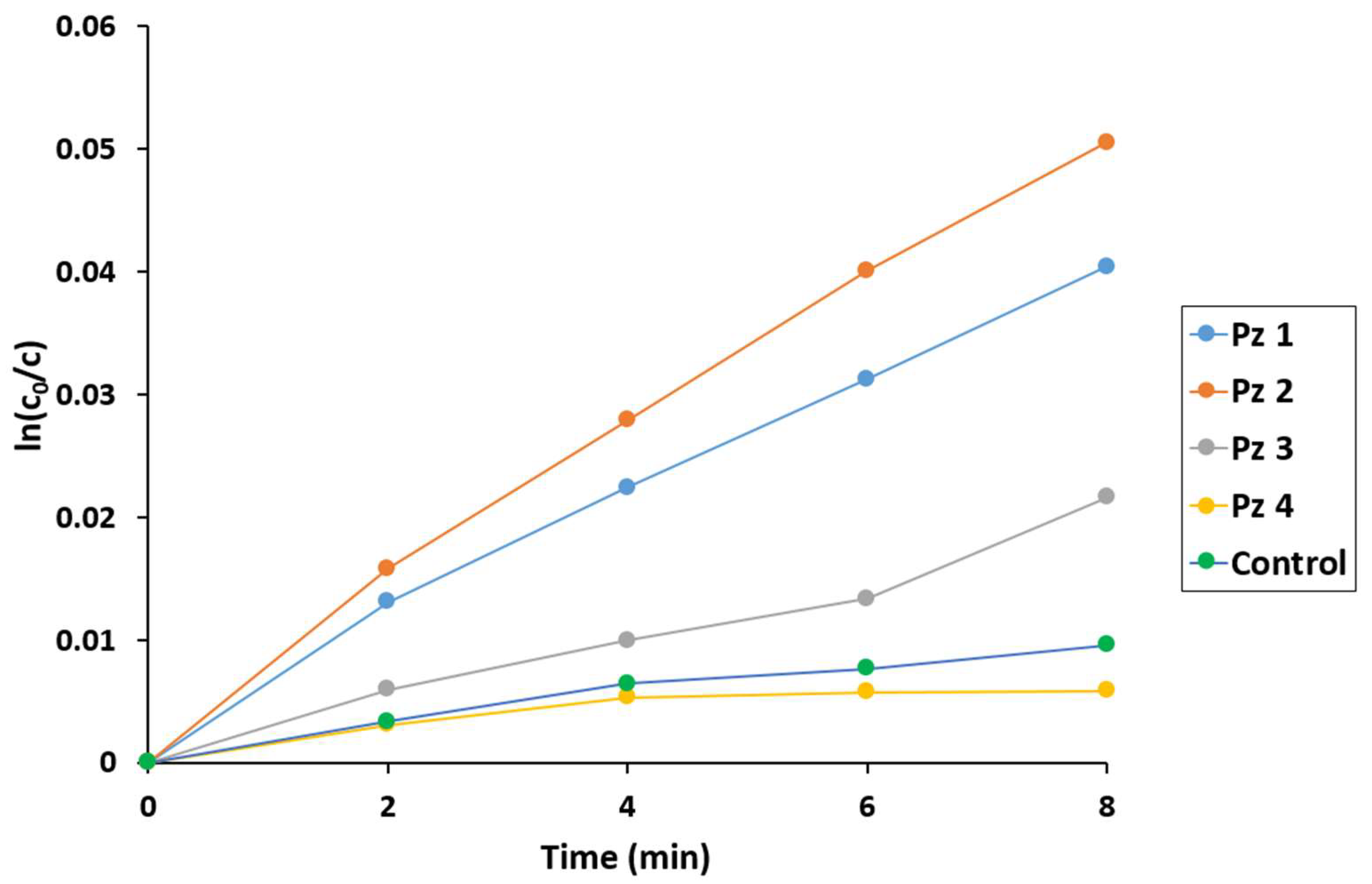
| Fe(I)/Pz(−1)/ Fe(I)/Pz(−2) (I) | Fe(I)/Pz(0)/ Fe(I)/Pz(−1) (II) | Fe(I)/Pz(0)/ Fe(II)/Pz(0) (III) | Fe(II)/Pz(0)/ Fe(III)/Pz(0) (IV) | Fe(III)/Pz(0)/ Fe(III)/Pz(+1) (V) | Fe(III)/Pz(+1)/ Fe(III)/Pz(+2) (VI) | II—V E1/2 gap (V) | ||
|---|---|---|---|---|---|---|---|---|
| Pz1 | E1/2 [V] vs. Fc+/Fc | −2.27 | −1.87 | −1.29 | −0.84 | 0.06 | 0.44 | 1.93 |
| ΔEp [mV] | 64 | 90 | 90 | - | 61 | 60 | ||
| Pz2 | E1/2 [V] vs. Fc+/Fc | −2.23 | −1.84 | −1.23 | −0.77 | 0.09 | 0.49 | 1.93 |
| ΔEp [mV] | 60 | 140 | 87 | - | 62 | 50 | ||
| Pz3 | E1/2 [V] vs. Fc+/Fc | −2.29 | −1.89 | −1.22 | −0.77 | 0.15 | 0.55 | 2.04 |
| ΔEp [mV] | - | 90 | 130 | - | 62 | 50 | ||
| Pz4 | E1/2 [V] vs. Fc+/Fc | −2.33 | −1.97 | −1.31 | −0.87 | 0.09 | 0.50 | 2.06 |
| ΔEp [mV] | - | 100 | 110 | - | 60 | 45 |
| Pz | H2O2 Δc/t × 107(mmol/min) | t-BuOOH Δc/t × 107(mmol/min) | ||
|---|---|---|---|---|
| DPBF | Pz Catalyst | DPBF | Pz Catalyst | |
| 1 | 6.7 | 17.0 | 12.0 | 8.6 |
| 2 | 6.2 | 18.0 | 15.0 | 8.5 |
| 3 | 4.3 | 7.3 | 6.4 | 4.9 |
| 4 | 2.1 | 2.6 | 1.8 | 2.0 |
Disclaimer/Publisher’s Note: The statements, opinions and data contained in all publications are solely those of the individual author(s) and contributor(s) and not of MDPI and/or the editor(s). MDPI and/or the editor(s) disclaim responsibility for any injury to people or property resulting from any ideas, methods, instructions or products referred to in the content. |
© 2023 by the authors. Licensee MDPI, Basel, Switzerland. This article is an open access article distributed under the terms and conditions of the Creative Commons Attribution (CC BY) license (https://creativecommons.org/licenses/by/4.0/).
Share and Cite
Koczorowski, T.; Rębiś, T. The Influence of an Extended π Electron System on the Electrochemical Properties and Oxidizing Activity of a Series of Iron(III) Porphyrazines with Bulky Pyrrolyl Substituents. Molecules 2023, 28, 7214. https://doi.org/10.3390/molecules28207214
Koczorowski T, Rębiś T. The Influence of an Extended π Electron System on the Electrochemical Properties and Oxidizing Activity of a Series of Iron(III) Porphyrazines with Bulky Pyrrolyl Substituents. Molecules. 2023; 28(20):7214. https://doi.org/10.3390/molecules28207214
Chicago/Turabian StyleKoczorowski, Tomasz, and Tomasz Rębiś. 2023. "The Influence of an Extended π Electron System on the Electrochemical Properties and Oxidizing Activity of a Series of Iron(III) Porphyrazines with Bulky Pyrrolyl Substituents" Molecules 28, no. 20: 7214. https://doi.org/10.3390/molecules28207214
APA StyleKoczorowski, T., & Rębiś, T. (2023). The Influence of an Extended π Electron System on the Electrochemical Properties and Oxidizing Activity of a Series of Iron(III) Porphyrazines with Bulky Pyrrolyl Substituents. Molecules, 28(20), 7214. https://doi.org/10.3390/molecules28207214






